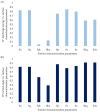Surface Wettability Modeling and Predicting via Artificial Neural Networks
- PMID: 39795836
- PMCID: PMC11721580
- DOI: 10.3390/ma18010191
Surface Wettability Modeling and Predicting via Artificial Neural Networks
Abstract
Surface wettability, defined by the contact angle, describes the ability of a liquid to spread over, absorb or adhere to a solid surface. Surface wetting analysis is important in many applications, such as lubrication, heat transfer, painting and wherever liquids interact with solid surfaces. The behavior of liquids on surfaces depends mainly on the texture and chemical properties of the surface. Therefore, these studies show the possibility of modeling surface wettability by adjusting the parameters of the surface texturing process. The prediction of the contact angle describing the wettability of the surface was performed using artificial neural networks. In order to select the most effective prediction model, the activation functions of neurons, the number of hidden layers and the network training algorithms were changed. The neural network model presented in these studies is capable of predicting the contact angle with an efficiency defined by the coefficient of determination R2 between real and predicted contact angles of over 0.9.
Keywords: artificial neural networks; contact angle; manufacturing; roughness; wettability.
Conflict of interest statement
The author declares no conflicts of interest.
Figures







Similar articles
-
Surfactant solutions and porous substrates: spreading and imbibition.Adv Colloid Interface Sci. 2004 Nov 29;111(1-2):3-27. doi: 10.1016/j.cis.2004.07.007. Adv Colloid Interface Sci. 2004. PMID: 15571660
-
Quantifying the impact of surface roughness on contact angle dynamics under varying conditions.Sci Rep. 2025 May 13;15(1):16611. doi: 10.1038/s41598-025-01127-7. Sci Rep. 2025. PMID: 40360554 Free PMC article.
-
Effects of surface wettability and liquid viscosity on the dynamic wetting of individual drops.Phys Rev E Stat Nonlin Soft Matter Phys. 2014 Aug;90(2):022401. doi: 10.1103/PhysRevE.90.022401. Epub 2014 Aug 4. Phys Rev E Stat Nonlin Soft Matter Phys. 2014. PMID: 25215736
-
Solid-liquid-liquid wettability and its prediction with surface free energy models.Adv Colloid Interface Sci. 2019 Feb;264:28-46. doi: 10.1016/j.cis.2018.10.003. Epub 2018 Oct 25. Adv Colloid Interface Sci. 2019. PMID: 30396508 Review.
-
A review on the wettability of dental implant surfaces I: theoretical and experimental aspects.Acta Biomater. 2014 Jul;10(7):2894-906. doi: 10.1016/j.actbio.2014.02.040. Epub 2014 Feb 28. Acta Biomater. 2014. PMID: 24590162 Free PMC article. Review.
References
-
- Jafari M., Jung J. Direct measurement of static and dynamic contact angles using a random micromodel considering geological CO2 sequestration. Sustainability. 2017;9:2352. doi: 10.3390/su9122352. - DOI
-
- Szymczyk K., Zdziennicka A., Krawczyk J., Jańczuk B. Wettability, adhesion, adsorption and interface tension in the polymer/surfactant aqueous solution system. I. Critical surface tension of polymer wetting and its surface tension. Colloids Surf. A Physicochem. Eng. Asp. 2012;402:132–138. doi: 10.1016/j.colsurfa.2012.02.054. - DOI
-
- Rbihi S., Aboulouard A., Laallam L., Jouaiti A. Contact Angle Measurements of Cellulose based Thin Film composites: Wettability, surface free energy and surface hardness. Surf. Interfaces. 2020;21:100708. doi: 10.1016/j.surfin.2020.100708. - DOI
-
- Yoshimitsu Z., Nakajima A., Watanabe T., Hashimoto K. Effects of surface structure on the hydrophobicity and sliding behavior of water droplets. Langmuir. 2002;18:5818–5822. doi: 10.1021/la020088p. - DOI
-
- Young T.J., Jackson J., Roy S., Ceylan H., Sundararajan S. Tribological behavior and wettability of spray-coated superhydrophobic coatings on aluminum. Wear. 2017;376–377:1713–1719. doi: 10.1016/j.wear.2016.12.050. - DOI
Grants and funding
LinkOut - more resources
Full Text Sources

